Often portrayed as a cartoon villain, North Korean dictator Kim Jong Un proved himself to be quite the contrary in 2017, openly challenging the U.S. and the international community with new threats.
This young murderous tyrant showed the world that he will go to any length to secure his reign, from killing family to forcing his people to make brutal sacrifices for the development of weapons of mass destruction.
At the start of the year, Kim delivered a New Year’s address, declaring that the rogue North Korean state was close to testing a weapon that could finally threaten the continental U.S. “We have reached the final stage of preparations to test-launch an intercontinental ballistic missile,” he revealed, adding: “Research and development of cutting edge arms equipment is actively progressing.”
Then President-elect Donald Trump pitted himself against the young despot, tweeting: “It won’t happen!” The two world leaders have been at loggerheads for most of the year, with the president threatening maximum pressure, including the application of military force, and Kim strongly warning that the North will not be bullied into submission.
In mid-February, only a few weeks after Trump took office, North Korea successfully tested the Pukguksong-2 medium-range ballistic missile, a previously unseen road-mobile solid-fueled missile. This weapon, which featured several important technological breakthroughs, was the first of five new ballistic missiles rolled out this year, and it may very well be the predecessor to a new solid-fueled weapon to be revealed at some point in the future.

A view of the test-fire of Pukguksong-2 guided by North Korean leader Kim Jong Un on the spot, in this undated photo released by North Korea’s Korean Central News Agency (KCNA) in Pyongyang February 13, 2017. KCNA/Handout via Reuters
That same month, Kim’s half-brother Kim Jong Nam, who some argue was the rightful heir, was assassinated in an international airport in Malaysia with a nerve agent so deadly it is classified as an illicit weapon of mass destruction. The hit was carried out by two girls from Indonesia and Vietnam, however, the shocking murder is believed to have been orchestrated by Pyongyang, as at least half a dozen people from North Korea were involved in the assassination of Kim Jong Nam.
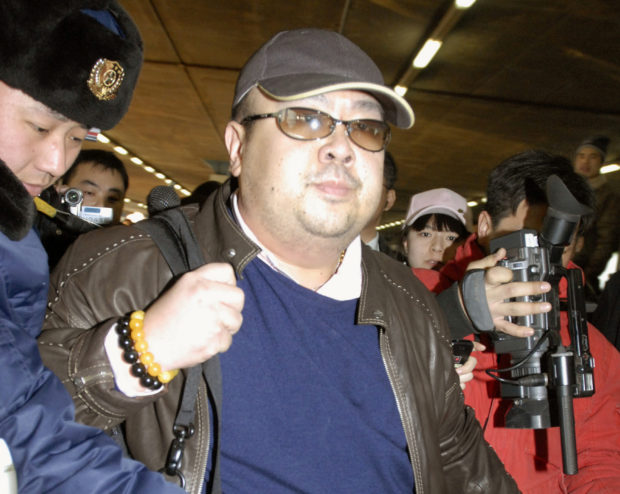
Kim Jong Nam arrives at Beijing airport in Beijing, China, in this photo taken by Kyodo February 11, 2007. Picture taken February 11, 2007. Mandatory credit Kyodo/via REUTERS
Former North Korean diplomat Thae Yong Ho revealed in October that Kim faced a crisis of legitimacy when he took power after his father passed away six years ago. He had his uncle executed and purged disloyal officials, and his exiled half-brother is believed to have been a target for many years. The use of a banned chemical nerve agent in an international airport to murder the oldest son of the late Kim Jong-il led Trump to name North Korea a state sponsor of terrorism in November.
The common theme in most of Kim’s actions — be it murder or weapons development — is regime survival and the permanent preservation of his power and authority.
The North launched a salvo of extended-range Scud missiles into the East Sea/Sea of Japan in March, asserting that the Korean People’s Army was practicing striking American bases in Japan. This provocation led the Trump administration to expedite missile defense plans for South Korea and begin deploying a Terminal High Altitude Area Defense (THAAD) system on the Korean Peninsula to protect the South from North Korean aggression.

North Korean leader Kim Jong Un supervised a ballistic rocket launching drill of Hwasong artillery units of the Strategic Force of the KPA on the spot in this undated photo released by North Korea’s Korean Central News Agency (KCNA) in Pyongyang March 7, 2017. KCNA/via REUTERS
The deployment of THAAD, which further stirred regional tensions, marked the start of extensive efforts by both South Korea and Japan to strengthen each country’s defensive capabilities. The U.S. also conducted multiple missile intercept drills throughout 2017 to test the systems designed to protect the U.S. against North Korean weapons.
The following month, the threat of war appeared to be lurking just over the horizon. The Trump administration had just bombed Syria and Afghanistan, and a powerful “armada” was reportedly moving into position just off the Korean Peninsula. At the same time, news of construction at North Korea’s Punggye-ri Nuclear Test Site led some to conclude that a sixth nuclear test was imminent, and rumors began to surface that the U.S. might strike the North if it tested another nuclear device.
Everything was expected to go down around April 15, the Day of the Sun — the 105th anniversary of the birth of Kim Il Sung, the founder of North Korea and Kim Jong Un’s grandfather.
North Korea did not test a nuclear device; rather, it marked this important day with a military parade and a failed ballistic missile test, one of three in April. And it turned out that the American carrier strike group that was supposedly sitting just off the peninsula was actually located thousands of miles away.
The rogue state found its footing again in May and fired off two new ballistic missiles — a high-precision short-range Scud missile designed to potentially evade enemy defenses and the Hwasong-12 intermediate-range ballistic missile, the stepping stone to North Korea’s first intercontinental ballistic missile and a weapon able to deliver a nuclear payload to the U.S. territory of Guam in the Pacific.
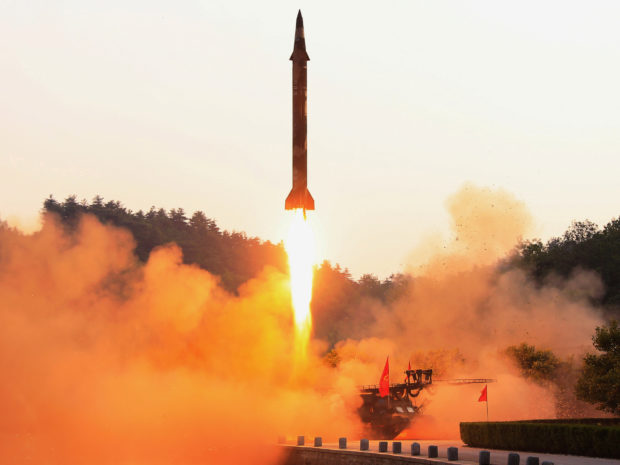
A ballistic rocket is test-fired through a precision control guidance system in this undated photo released by North Korea’s Korean Central News Agency (KCNA) May 30, 2017. KCNA/via REUTERS
In the wake of the successful test of the Hwasong-12 IRBM, the South Korean defense minister conceded that the North’s ballistic missile development program was progressing much faster than initially expected.
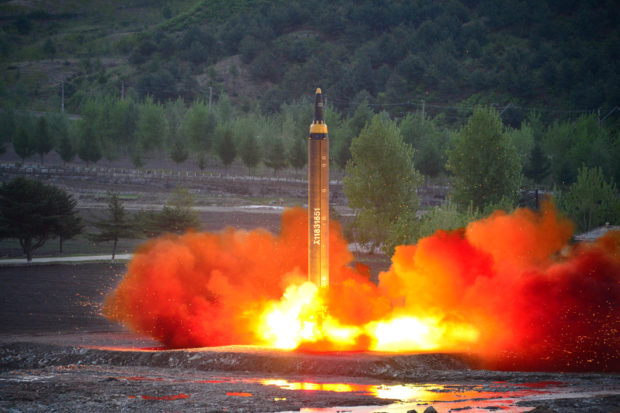
The long-range strategic ballistic rocket Hwasong-12 (Mars-12) is launched during a test in this undated photo released by North Korea’s Korean Central News Agency (KCNA) on May 15, 2017. KCNA via REUTERS
North Korea also tested the Pukguksong-2 MRBM again and then declared its ready for mass production.

The scene of the intermediate-range ballistic missile Pukguksong-2’s launch test in this undated photo released by North Korea’s Korean Central News Agency (KCNA) May 22, 2017. KCNA/via REUTERS/File photo
With the North Korea weapons threat looming over global peace and security, a new issue arose in June. In a burst of good news, it came to light that Otto Warmbier, a University of Virginia student who was detained in North Korea for over a year for allegedly stealing a propaganda poster, was coming home. But, joy turned to sorrow as news broke that the young college student was in a coma. He died of his ailments one week after arriving in the U.S.
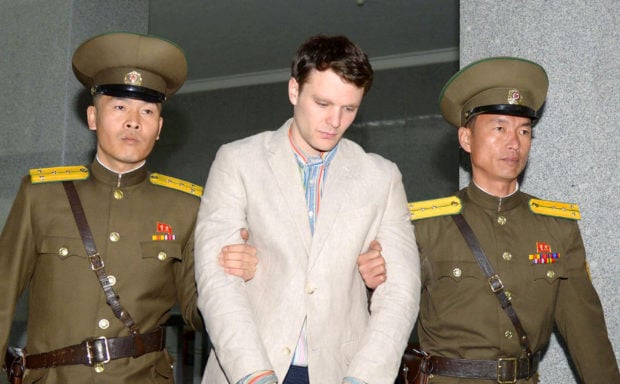
Otto Frederick Warmbier (C), a University of Virginia student who was detained in North Korea since early January, is taken to North Korea’s top court in Pyongyang, North Korea, in this photo released by Kyodo March 16, 2016. Mandatory credit REUTERS/Kyodo/File Photo
North Korea claims he developed a rare type of food poisoning, however, Warmbier’s parents assert that he was brutalized and tortured by the regime. Medical professionals have had difficulty finding evidence to support either claim.
Nonetheless, Warmbier’s death has become a rallying cry for the Trump administration and an example of North Korea’s cruelty. In several different speeches critical of North Korea, the president has brought up the tragic story of Warmbier, who’s death led the administration to ban Americans from traveling to North Korea.
North Korea is still holding three other American citizens in captivity.
At the start of the next month, North Korea decided to celebrate the Fourth of July with a bang. The North successfully launched the new Hwasong-14 ICBM for the first time. Experts analyzed the launched data and concluded the missile could potentially reach Alaska, as well as some West Coast cities.

The intercontinental ballistic missile Hwasong-14 is seen in this undated photo released by North Korea’s Korean Central News Agency (KCNA) in Pyongyang July 5, 2017. KCNA/via REUTERS
Towards the end of July, North Korea tested the Hwasong-14 ICBM again, launching it at full power. The flight data for the missile suggested that it could strike parts, if not most, of the continental U.S.
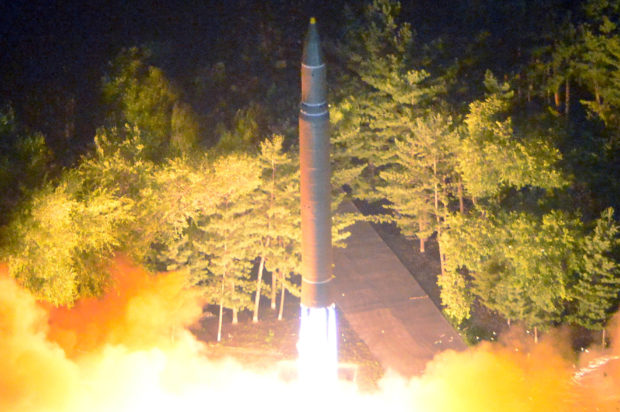
Intercontinental ballistic missile (ICBM) Hwasong-14 is pictured during its second test-fire in this undated picture provided by KCNA in Pyongyang on July 29, 2017. KCNA via Reuters
In response, the United Nations, as well as the U.S. and its allies, placed tough sanctions on North Korea.
Talk of war with North Korea surfaced again in August. The Washington Post revealed the Defense Intelligence Agency had concluded that North Korea had at least 60 nuclear warheads in its possession and the ability to mount them on its ballistic missiles, including its ICBM.
This report appeared to prompt an unusual threat from Trump. “North Korea best not make any more threats to the United States,” he told the White House press pool, adding: “They will be met with the fire and fury like the world has never seen.”
At the same time, North Korea revealed that the Korean People’s Army was in the process of developing a plan to ring Guam with Hwasong-12 IBRMs. The purpose, according to North Korean state media, was to teach Trump a lesson, arguing that the only thing the president understands is force.
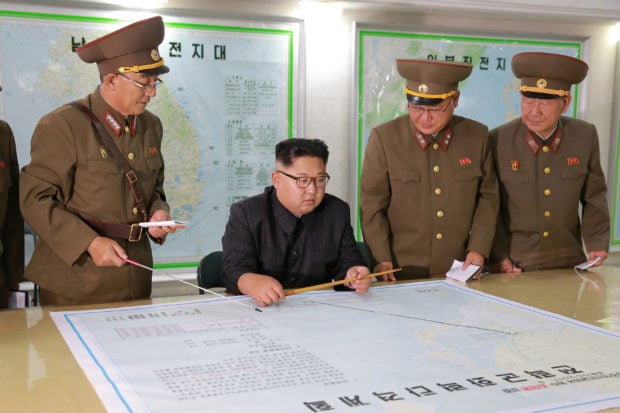
North Korean leader Kim Jong Un visits the Command of the Strategic Force of the Korean People’s Army (KPA) in an unknown location in North Korea in this undated photo released by North Korea’s Korean Central News Agency (KCNA) on August 15, 2017. KCNA/via REUTERS
Later that week, Trump tweeted that the military was “locked and loaded” for a military solution to the North Korea problem, causing some to fear that the president intended to go to war with North Korea.
Tensions faded without much explanation, and North Korea ultimately decided to hold off in its plan, claiming that it intended to give America time to change its hostile policy towards the rogue state. The resulting de-escalation led the Trump administration to assume that North Korea was starting to respect the U.S., but the administration was forced to eat those words.
Towards the end of the month, North Korea conducted an unprecedented ballistic missile test, launching a Hwasong-12 IRBM along a standard trajectory over Japan and into the Pacific. The North carried out another such test the following month, demonstrating clearly the ability to strike Guam.
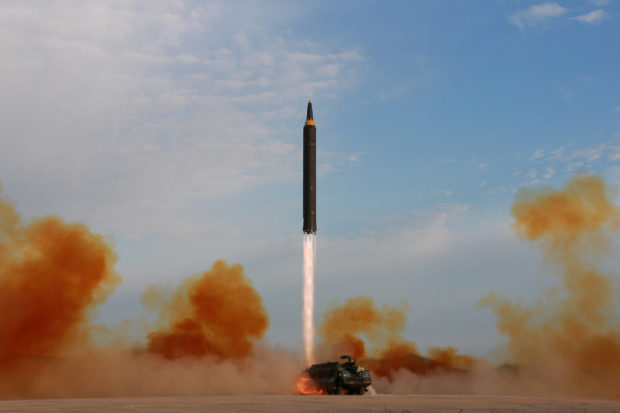
North Korean leader Kim Jong Un (not pictured) guides the launch of a Hwasong-12 missile in this undated photo released by North Korea’s Korean Central News Agency (KCNA) on September 16, 2017. KCNA via REUTERS
North Korea upped the ante shortly thereafter. Three days into September, the North detonated a staged thermonuclear device, a hydrogen bomb that produced an explosive yield of a few hundred kilotons. This provocative test shook the world, as North Korea had successfully tested a weapon designed to level cities.
Prior to this test, North Korea released images of the warhead it intended to load onto its Hwasong-14 ICBM.
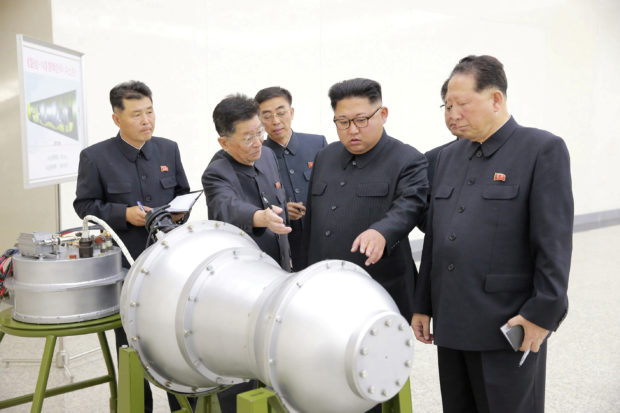
North Korean leader Kim Jong Un provides guidance with Ri Hong Sop (2nd L) and Hong Sung Mu (R) on a nuclear weapons program in this undated photo released by North Korea’s Korean Central News Agency (KCNA) in Pyongyang September 3, 2017. KCNA via REUTERS
This test was followed by more hard-hitting sanctions, punitive measures so tough that a former North Korean money man predicted North Korea would not last a year under such intense pressure.
Speaking at the United Nations General Assembly later that month, Trump warned North Korea of the consequences should it misstep and use force to disrupt global peace and stability. “The United States is a nation of great strength and patience, but if it is forced to defend itself or its allies, we will have no choice but to totally destroy North Korea,” the president said.

U.S. President Donald Trump addresses the 72nd United Nations General Assembly at U.N. headquarters in New York, U.S., September 19, 2017. REUTERS/Brendan McDermid
Not only did this line lead North Korea’s foreign minister to make wild threats about a nuclear test in the Pacific and the possibility that the North might attempt to shoot down the American bombers that regularly flew over the Korean Peninsula in a show of force, but it also prompted Kim Jong Un to address Trump directly in an unprecedented North Korean state media report.
“I’d like to advise Trump to exercise prudence in selecting words and be considerate to whom he speaks to when making a speech in front of the world,” Kim said. “I will surely and definitely tame the mentally-deranged dotard with fire.”
After another shot over Japan, North Korea was eerily quiet for nearly two months.
A North Korean soldier made international headlines in mid-November with a daring dash toward freedom in the Joint Security Area at the heavily fortified DMZ. Oh Chong Song made his escape first in a jeep and then on foot, his comrades hot on his tail. He was shot five times, but he lived.

A North Korean soldier keeps watch toward the south in front of their guard post just next to a spot where a North Korean has defected crossing the border on November 13, at the truce village of Panmunjom inside the demilitarized zone, South Korea, November 27, 2017. REUTERS/Kim Hong-Ji
Medical professionals called the young man’s survival a “miracle.”
North Korea overcame the embarrassment of this defection with an alarming test of a brand new, extremely-powerful ballistic missile at the end of the month.

A view of the newly developed intercontinental ballistic rocket Hwasong-15’s test that was successfully launched is seen in this undated photo released by North Korea’s Korean Central News Agency (KCNA) in Pyongyang November 30, 2017. REUTERS/KCNA
The Hwasong-15 ICBM tested in the final days of November is believed to possess the ability to strike anywhere in the continental U.S. This achievement marked the completion of North Korea’s nuclear forces, according to the young North Korean dictator. Despite this claim, more testing is expected.
Following this test, the United Nations imposed even tougher sanctions on North Korea, crippling both critical imports and exports to break the North Korean economy. The North, however, is refusing to back down or abandon its nuclear arsenal.
“Do not expect any change in policy,” North Korean state media stressed Saturday, adding that the North will “continue bolstering the capabilities for self-defense and preemptive attack with the nuclear force as the pivot.” As de-escalation channels are inactive, tensions will almost certainly continue to rise in the year ahead.
RELATED:
The Daily Caller News Foundation is working hard to balance out the biased American media. For as little as $3, you can help us. Freedom of speech isn’t free. Make a one-time donation to support the quality, independent journalism of TheDCNF. We’re not dependent on commercial or political support and we do not accept any government funding.
All content created by the Daily Caller News Foundation, an independent and nonpartisan newswire service, is available without charge to any legitimate news publisher that can provide a large audience. All republished articles must include our logo, our reporter’s byline and their DCNF affiliation. For any questions about our guidelines or partnering with us, please contact licensing@dailycallernewsfoundation.org.



